|
Report
from
Europe
UK leads a slow recovery in the EU
According to a preliminary estimate by Eurostat, GDP
rose by 0.1% in the EU28 and fell by 0.4% in the euro area
during 2013. Quarterly data shows that the European
economy has been recovering slowly since the second
quarter of 2013 (Chart A).
Of the large EU countries, the UK was the best performing
economy in 2013. The UK's services and manufacturing
sectors were the drivers of 0.7% growth in the fourth
quarter, taking the annual growth rate to 1.9%, the
strongest since 2007.
In the euro-zone, 0.4% and 0.3% GDP growth respectively
in Germany and France in 2013 helped offset further
declines in Italy and Spain. However, all these economies
were recovering slowly in the second half of 2013.
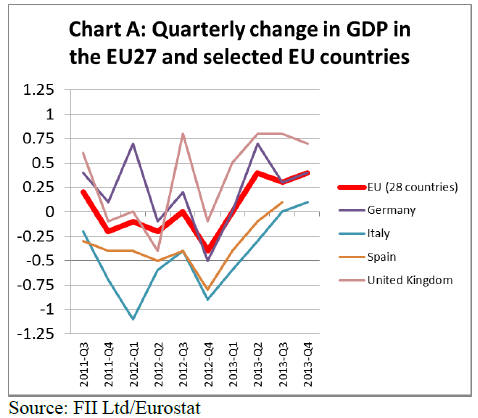 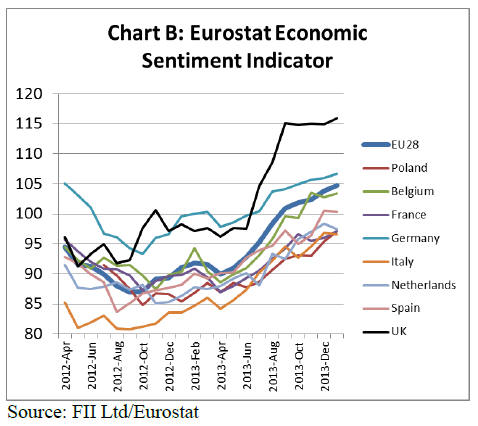
Fragile recovery in the euro-zone
The euro zone's fragile economy improved modestly in the
final quarter of 2013. GDP increased 1.1% at an
annualized rate during the period. Recent growth is being
buoyed by gains in exports and investment which is
helping offset sluggish consumer spending.
However growth is still well below the pace needed to
make a dent in near record-high unemployment or to
alleviate debt burdens in Southern Europe.
Nevertheless, with a value of $12.7 trillion, the euro-zone
economy remains the second-biggest in the world behind
the U.S. Official and private-sector estimates peg growth
of around 1% across the region during 2014. This suggests
that while the euro-zone won't be a drag on the global
economy this year, it is unlikely to provide much of a lift
to its trading partners either.
With the exception of Germany - which is renowned for
its export prowess- the outlook for euro-zone growth is
insufficient to propel much new investment and hiring.
That leaves much of the currency bloc vulnerable to
shocks from the global economy, financial markets or
renewed political uncertainty.
More positively, economic sentiment was improving
across the EU during the second half of 2013 (Chart B).
For the EU28 as a whole, the Eurostat Economic
Sentiment Indicator has exceeded 100 since August 2013.
This implies above average sentiment across all five
economic sectors (industry, services, retail trade,
construction and consumers). Economic sentiment is
particularly good in the UK and Germany.
Broad-based recovery in the UK
Prospects look much improved in the UK as economic
recovery is now apparent across a wide range of industrial
sectors. Britain's dominant services sector expanded by
0.8% between October and December 2013, while the
construction sector increased by 0.2%.
British manufacturing increased by 0.9%, with industrial
production overall up by 0.7%, while agricultural output
increased by 0.5%.
Of particular note for the wood industry, house building in
the UK staged a dramatic recovery in 2013. British
builders enjoyed their best year since the financial crisis
struck.
The UK Office for National Statistics reports that new
housing construction jumped 10.4% to £22.1 billion in
2013. That is the highest level since 2007. The surge
pushed output across the construction sector up 1.3% to
£112.6 billion in 2013, 3.9% higher than the low in 2009
but still 12.2% below the 2007 peak of £128.2 billion.
Very slow recovery in construction in other EU
countries
Construction activity throughout the whole of EU is
currently running at around 95% of the level in 2010
(Chart C). Activity in Germany maintained a relatively
high level throughout 2013.
Activity was also showing signs of recovery in Belgium,
Poland and France during the second half of 2013.
However construction activity remained at a very low
level in Italy and Spain throughout the year.
The Eurostat Building Permits Index, an indicator of
future activity, suggests only very slow recovery in
construction activity in the EU during 2014 (Chart D).
Building permits were rising strongly in the UK and
Germany in the second half of 2013.
However the number of building permits issued in Spain
and the Netherlands declined sharply during this period.
Overall building permits issued in the 3rd quarter of 2013
were only around 80% of the level prevailing in 2010.
 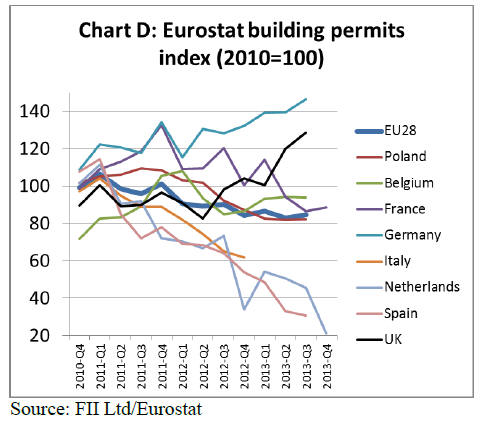
EU wood flooring consumption down 5% in 2013
After a year in which overall European wood flooring
consumption fell by 5.9%, first estimates suggest the
market contracted another 5% in 2013. This is based on
comments received from member country representatives
at the FEP (European Federation of the Parquet Industry)
meeting held at the DOMOTEX fair in Hannover in
January 2014.
As in previous years, the results show some variation
between European countries and from quarter to quarter.
However, the overall picture is not as diverse as it once
was. Indeed, countries which were performing rather well
and driving the markets upwards also lost momentum in
2013.
Markets in the south of the EU (e.g. Spain, Italy, and
France) still face serious difficulties and probably
experienced double digit decline in 2013. The situation is
better in northern Europe, but developments are still
slightly negative or, in the best case, stable (e.g. in
Sweden).
Central Europe remains the best performing region,
particularly Switzerland with expected growth of 6% in
2013. Consumption in Austria and Germany is estimated
to have remained stable between 2012 and 2013.
According to FEP, these figures ¡°have to be seen in the
light of the major challenges faced by the sector in 2013
and still faced today, notably the continuously stiff
competition, extremely high unemployment rates in some
important EU regions and ever uncertain exchange rates,
especially the EUR/USD rate¡±.
However FEP also note that the latest economic forecasts
provide some grounds for optimism. FEP stress the
conclusions of recent FEP consumer perception studies
¡°which confirm that parquet is a great natural product,
very much valued and desired by consumers, who see real
wood parquet as an indispensable element of interior
decoration of the future.¡±
Big fall in EU wood flooring trade deficit
While European wood flooring consumption remains
slow, there are signs that EU wood flooring manufacturers
have adjusted to the new market situation by significantly
boosting competitiveness in international markets.
This is suggested by the recent rise EU exports of wood
flooring to other regions and by a sharp decline in EU
imports of wood flooring. The value of the EU‟s trade
deficit in wood flooring has fallen from euro 281 million
to only euro68 million in only three years (Table 1).
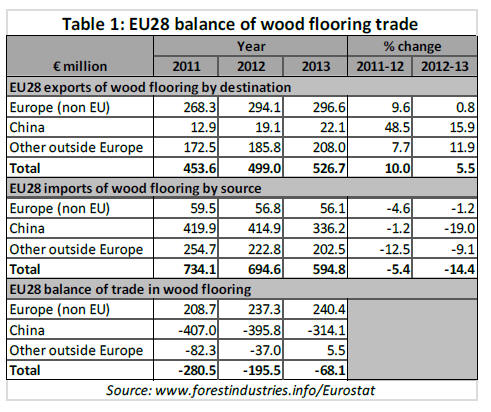
Between 2012 and 2013, the value EU28 wood flooring
exports increased by 5.5% to €527m. This followed a 10%
increase in export value between 2011 and 2012. Most of
the export gains in 2013 were to markets outside the
European continent, notably USA, Turkey and China
(Chart 1).
This is in contrast to 2012 when most of the rise in exports
was destined for other European countries (mainly
Switzerland and Norway).
Last year, EU imports of wood flooring from outside the
region fell by over 14% to €595 million. Imports from
China, by far the largest external supplier to the EU, fell
19% to €336.2 million.
All the main EU markets imported less Chinese wood
flooring during 2013, including UK, Belgium, Italy,
Germany, Netherlands, Sweden and France (Chart 2).
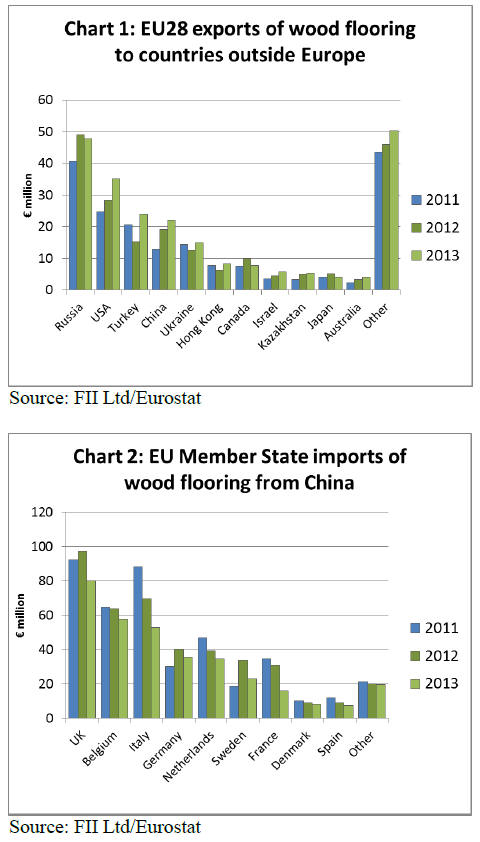
While much of the decline in imports is due to China, EU
imports also declined from most tropical producing
countries during 2013 (Chart 3). EU import value of wood
flooring fell sharply from Indonesia (-22% to euro 33m),
Malaysia (-19% to euro 26.7m), Brazil (-12% to
euro13.6m), Viet Nam (-27% toeuro€4m) and Thailand (-
41% to euro2.9m).
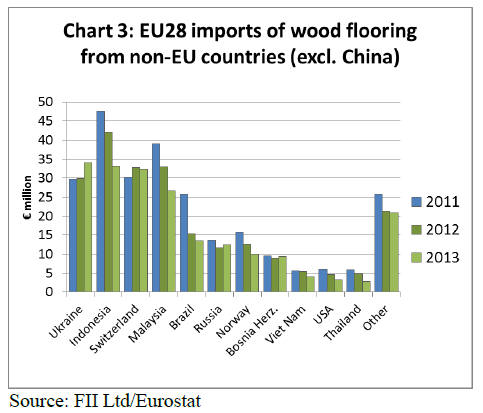
Domotex highlights dominant position of oak in
European flooring
Domotex is Europe‟s leading flooring sector trade show
held each year in Hannover, Germany during January.
Every year for the last decade, the wood content of the
show has become increasingly dominated by engineered
wood flooring faced with oak.
In relation to wood species, the only observable trend has
been the increasingly wide and creative range of oak
finishes. This year was no different with some companies
promoting up to 150 finishes of oak. Other species, both
tropical and temperate, have been pushed to the side-lines.
From the perspective of overall wood flooring demand, the
Domotex show provided reasons for optimism about the
future. After an attendance drop in 2013, the show
rebounded 11% to 45,000 visitors and attracted 1,350
exhibitors from 57 countries.
It was also encouraging that two large halls this year were
dedicated to wood and laminate flooring. Some of the
bigger brands who also produce laminate and non-wood
flooring were showing a wider range of real wood
products. Most of the biggest European flooring brands
were exhibiting this year.
This contrasts with 2013 when some opted instead for the
German building show Bau held at the same time. There
were quite a few Chinese producers promoting their
products to European buyers, but perhaps not as many as
in the past. This year there appeared to be more producers
from Central Europe including Hungary, Czech Republic,
Poland, Croatia and Serbia.
The show highlighted that the rustic antique look remains
strong in in the wood flooring sector. This trend is one the
producers clearly want to perpetuate as they are able to
source cheaper lower grades and small dimension oak
lumber, especially from Central and Eastern Europe.
Manufacturers were generally confident of continuity of
supply and stable prices for this lower grade material. This
contrasts with supply of joinery grades of European oak
and most grades of U.S. oak which are currently
experiencing supply shortages and firming prices.
One indication that the European wood flooring market is
recovering is provided in a comment by a US hardwood
supplier attending Domotex quoted in the US-based
journal Hardwood Floors. He notes that ¡°In comparison to
2013, [European] buyers seem much more focused on
availability than price. Most buyers are aware of the tight
supply of U.S. hardwoods and are responding more
aggressively than this time last year.¡±
Much of the oak on display appeared to be of European
origin, although most large European flooring
manufacturers are also buying significant volumes of
American white oak. Other species being promoted,
although much less prominent than oak, were walnut
(almost all American) and ash (European and American).
Some brands were marketing a few tropical species but
there was no maple or cherry.
Mixed messages for tropical wood at Domotex
The Domotex show sent out mixed messages for tropical
hardwoods. In addition to evidence of declining usage,
there was the usual negative commentary by suppliers of
competing products on the environmental profile of
tropical hardwood. MOSO was promoting bamboo
flooring on grounds that it offered ¡°an ecological and
long-lasting alternative to patio floorboards made of ever
scarcer tropical woods¡±.
MOSO claimed that‟s patented bamboo treatment process
¡°gives the outdoor floorboards a level of hardness, shape
stability and resistance that exceeds that of even the best
tropical hardwoods¡±. MOSO also claimed "carbonneutrality"
for their product based on "an official Life
Cycle Assessment following the ISO 14040 and 14044
standard".
More positively for tropical wood, a press release issued
by the Domotex organisers highlights - as a ¡°Hot Topic in
2014¡± - the availability of VLEGAL certified teak flooring
from Indonesia.
The press release notes that ¡°under the 2013 EU Timber
Regulation, operators placing timber on the EU market
must demonstrate that they have not imported illegally
harvested wood. Indonesia with its VLEGAL certification
and documentation system offers a foundation for legal
wood harvesting that is recognized by the EU¡±.
The press release draws on information supplied to
Domotex by the Import Promotion Desk (IPD), a project
for trade promotion financed by the German Ministry for
Economic Cooperation (BMZ) together with its
cooperation partner SIPPO (Swiss Import Promotion
Programme). The project helped finance participation by
several Indonesian flooring manufacturers at the Domotex
show.
* The market information above has been generously provided by the
Chinese Forest Products Index Mechanism (FPI)
|